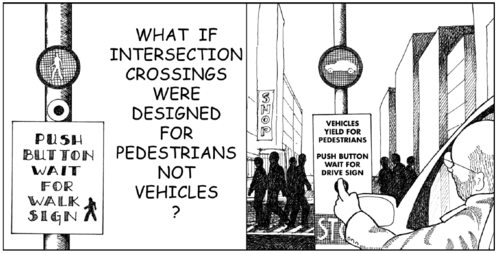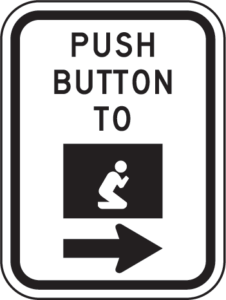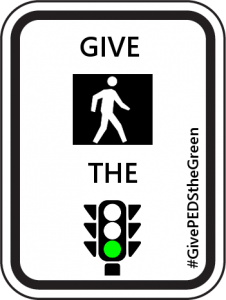This post is also posted on The Urbanist
Jonathan Glick and his son live in the Central District and often walk across 23rd Avenue. The street is a major thoroughfare and recently has been rebuilt. One wet evening, they went out to pick up dinner and walked along Union Street on the way back home. But, with dinner in one hand, and his toddler’s hand in the other, Jonathan couldn’t activate the pedestrian signal at 23rd Avenue in time. The awkward reach for the button with a heavy bag of burritos caused the two to miss their chance – leaving them standing in a winter storm until the next light cycle.
Over the course of the past year, Seattle has chipped away at dangers to pedestrian safety and obstacles to comfort. SDOT adopted a Director’s Rule for Pedestrian Mobility In and Around Work Zones, requiring safe access for pedestrians around construction sites and allowing fewer sidewalk closures. And the city council voted to lower default speed limits around the city to a safer 25 miles per hour on arterials and 20 in residential areas.
But there’s still another clear opportunity to improve safety further and substantially improve comfort for people walking: do something about those “push to cross” buttons, better known as “beg buttons”, all over the city.
Whether you don’t hit the beg button in time or don’t even notice it, you have two options for what to do when you miss your chance for the walk signal like the Glicks did:
- If you want to be an obedient Seattleite, push the button and wait your turn. This means you get to see all those cars go in the same direction that you want to with their green light, while you’re stuck standing there and staring at that red hand. Then, you wait for everyone else to go in all other directions, before finally, minutes later, you get your chance to cross. In Jonathan’s case, he stood with his son getting colder and wetter, realizing that the city hadn’t thought enough about pedestrians. For those recent transplants who aren’t familiar with waiting for the signal here’s an example of what it’s like to wait it out:
Feeling frustrated, you might choose another approach… - Eschewing Seattle tradition and risking life and limb, you decide to live boldly and scamper across the street. You then notice those turning drivers that aren’t expecting anyone to be crossing and who suddenly notice you too, in time to avoid making you a hood ornament. Breathless and invigorated, you feel like you’ve avoided the worst until you see that police officer waiting for you on the opposite curb…
Frankly, both options are unacceptable: nobody wants to wait when they “should” have the right of way, but crossing against the signal exacerbates conflict between people driving and walking and is dangerous for everyone. In short, having to push a button to cross makes you inconvenienced at best and vulnerable at worst. And, pedestrians are already the most vulnerable roadway users; people walking who are hit by a car are more likely to die in a collision than bicyclists or drivers.
In a New York Times editorial, Tom Vanderbilt, the author of Traffic: Why We Drive the Way We Do (and What It Says About Us) says, “Pedestrians, who lack airbags and side-impact crash protection, are largely rational creatures.” He argues against beg buttons, saying, “When you actually give people a signal, more will cross with it. As the field of behavioral economics has been discovering, rather than penalizing people for opting out of the system, a more effective approach is to make it easier to opt in.”
“Push-buttons almost always mean that the automobile dominates,” says City planner Jeff Speck in his book Walkable City. He continues, “Far from empowering walkers, the push button turns them into second-class citizens; pedestrians should never have to ask for a light.”

Comic by Dhiru Thadani
In fairness, Seattle doesn’t have beg buttons everywhere, and the Seattle Department of Transportation has criteria that determine where push buttons don’t belong. According to SDOT city traffic engineer Dongho Chang, “This is determined by using counting equipment in the signal cabinet to record pedestrian crossing activation. High pedestrian use is currently defined as when crossing is activated 50% of the cycle for 12 hours. We will be evaluating updates to the guideline.”
And evaluate they should. First, SDOT undercounts the number of people who want to cross by only tracking when the button is pushed and not considering the people who don’t notice the button and the people who defy the button by jaywalking. Second, SDOT undermines Seattle’s Vision Zero plan for zero traffic deaths and serious injuries by 2030 as the stated goal of transportation policy by designing an experience that creates conflicts between drivers and walkers. Besides, these buttons are often unnecessary because in many cases the traffic light is green for plenty long enough to let pedestrians cross if the walk signal were activated, without any changes to signal timing.
To put this solution in perspective, there are some problems with our transportation network that will take millions of dollars to fix, or even billions, such as filling in the missing sidewalks across the city. But no change to our transportation network would be as cost effective at transforming the experience for people walking as removing beg buttons. A change in policy and signal programming would revolutionize what it means to be a pedestrian in Seattle.
People in other cities from Victoria to Venice and from Santa Monica to Sudbury, have made similar arguments against beg buttons, however, no city has changed their engineering approach to improve intersections for everyone.
In a world where Seattle’s political climate is more divergent than ever with national politics, now’s the time to take control of what we can control: our city.
Seattle can do this, and here’s how: ban beg buttons in all urban villages and urban centers and lower SDOT’s engineering threshold to have the beg button be eliminated for the entire day for any crosswalk signal that is activated 25% of the time for any 6-hour period during the day.
Transform the transportation network by positioning Seattle as a leader in safer streets and active transportation. Don’t discriminate against people walking – let all people cross the street at the same time whether walking, driving, or biking.
Give pedestrians the green.
So, how can you help make this happen?:
- Sign this petition to SDOT Director Scott Kubly asking for change.
- Tell everyone why the beg button should be banned under the hashtag #GivePedsTheGreen.
- Push the button. Always. As long as the push button is still used as a measurement of pedestrian activity, be sure to push it to make sure that SDOT counts people on foot when programming traffic signals.






